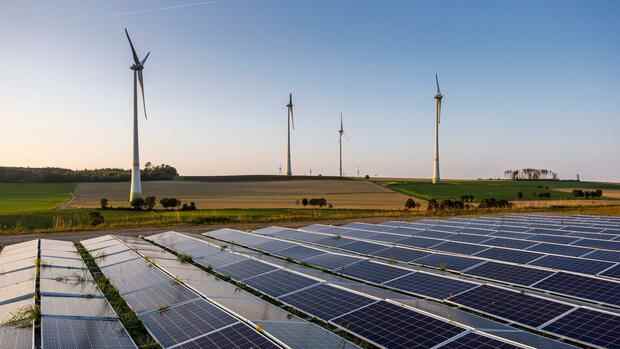The “Renewable Energy Standard” program remains part of Kfw’s Green Bond framework.
(Photo: imago images / Olaf Döring)
Frankfurt Green bonds will also play an important role in KfW’s refinancing in the coming year: The state development bank wants to borrow at least ten billion euros from investors in 2022 via so-called green bonds, as the development bank announced on Friday.
In fact, the volume of sustainable bonds is likely to be even higher: KfW initially only announced issues of ten billion euros for 2021 – but ultimately placed 16 billion euros.
This means that almost a fifth of KfW’s total issue volume in the current year consisted of sustainable bonds. Those who issue green bonds promise their investors that they will spend the money they collect on investments in, for example, climate protection. In addition, the issuers undertake to report regularly on the impact of their investments, such as how many tons of CO2 were saved.
KfW’s issuance plans are always important news for investors with a focus on sustainability: The development bank, which is 80 percent owned by the federal government and 20 percent by the federal states, is one of the most important and most stable “suppliers” of green interest-bearing paper. It is the largest issuer in Germany and number two behind France worldwide.
Top jobs of the day
Find the best jobs now and
be notified by email.
The number of green bond issuers is growing steadily, and the Federal Republic of Germany and the European Union are now also financing themselves in this way.
Green interest titles
Growing competition did not detract from the attractiveness of KfW securities, and investors’ appetite seems unbroken: The demand for KfW’s green bonds was so high this year that the promotional bank was even able to borrow slightly cheaper than conventional bonds.
There is also a large selection of green Zinstiteln: In the current year KfW placed a total of 37 different transactions in 13 different currencies. According to its own statements, KfW is now also feeling increased interest in privately placed bonds and has provided investors with such private placements in seven currencies.
The green bonds planned for next year are part of KfW’s 80 to 85 billion financing plan.
How large the green emission volume will actually be depends primarily on the demand for certain KfW funding programs. Because indirectly with its green bonds KfW only finances very specific loan programs that meet certain sustainability criteria.
Energy-efficient buildings, sustainable mobility, renewable energies
KfW is now updating this framework at the turn of the year. The “Energy Efficient Building” funding program, which expired in the summer, is being replaced by the “Federal Funding for Efficient Buildings” (BEG) program.
The KfW loans for energy-efficient buildings traditionally make up the majority of the loans that KfW counter-finances through green bonds. The strong demand for the “Energy Efficient Building” program was an important driver for the large supply of green KfW bonds this year.
At the turn of the year, the funding program for “sustainable mobility” will also be included in the green framework. The “Renewable Energy Standard” program remains part of the Green Bond framework. The program is based on the latest version of the Green Bond Principles of the ICMA capital markets association and has been externally assessed by the Norwegian green bond analysis company Cicero.
In 2014 KfW raised money for the first time via the then emerging market of “green bonds”. At the same time, KfW has always been actively committed to the development of standards so that a functioning infrastructure for green bonds is created.
Right from the start, she had external confirmation that her green bonds met all of the criteria and gave a detailed report on how she used the funds. “Of course, our investors can continue to rely on receiving comprehensive and transparent reporting on the use of funds from us,” said Treasury chief Tim Armbruster on Friday.
More: Petra Wehlert is largely responsible for KfW’s pioneering role in green bonds.
